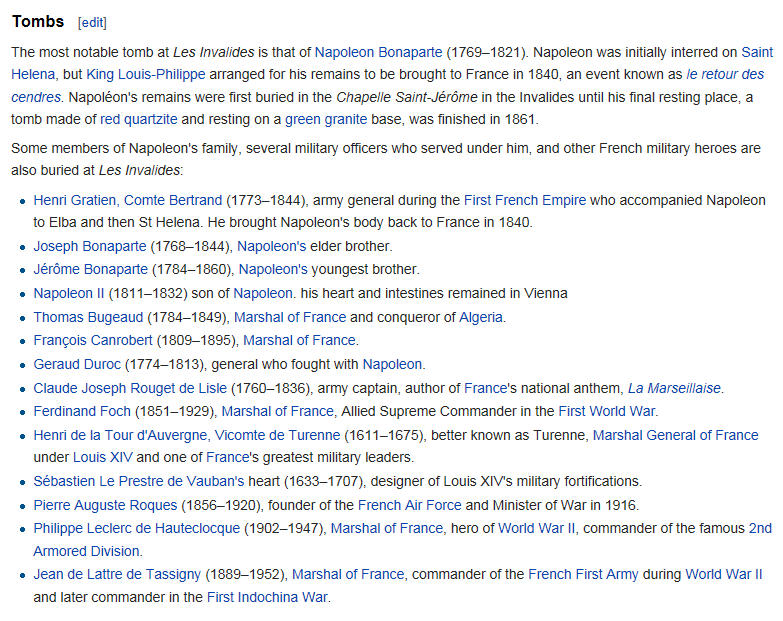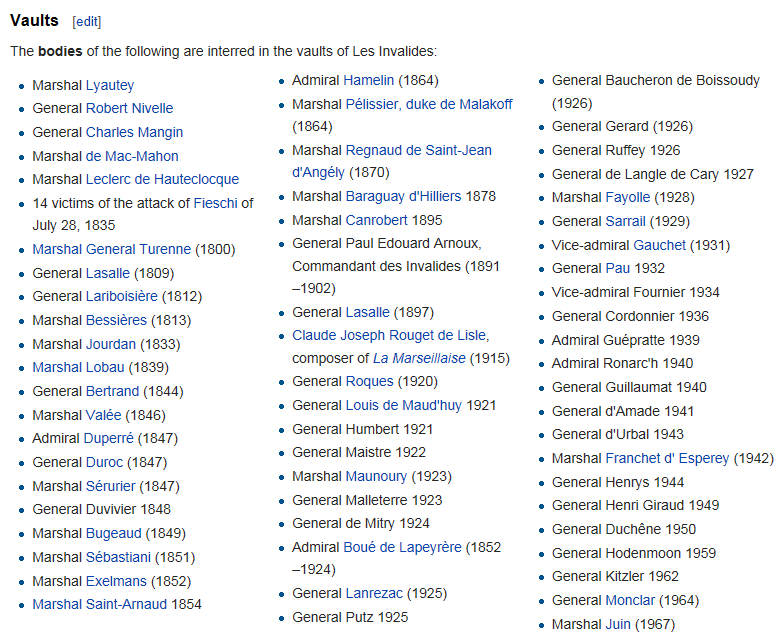Paris Odds and Ends
Lover's Lock Bridge -
Louvre/Mona Lisa - Jim Morrison Grave - Napoleon's Tomb -
Pantheon - More
Love Locks Bridge (Notre Dame Cathedral in
the background)
A love lock or love padlock is a padlock which sweethearts lock to a bridge, fence, gate, or similar public fixture to symbolize their love. Typically the sweethearts' names or initials are inscribed on the padlock, and its key is thrown away to symbolize unbreakable love. Since the 2000s, love locks have proliferated at an increasing number of locations worldwide. They are often treated by municipal authorities as litter or vandalism, and there is some cost to their removal. This particular bridge is near Notre Dame Cathedral.
.jpg)
.jpg)
.jpg)
.jpg)
________________________________________________
The Louvre and Mona Lisa - It would take a couple of days to really see everything in the Louvre
.jpg)
.jpg)
.jpg)
.jpg)
.jpg)
.jpg)
Mona Lisa room - There's Mona on the left
.jpg)
.jpg)
.jpg)
.jpg)
.jpg)
.jpg)
.jpg)
.jpg)
.jpg)
.jpg)
.jpg)
.jpg)
.jpg)
.jpg)
.jpg)
.jpg)
.jpg)
.jpg)
.jpg)
.jpg)
.jpg)
_____________________________________________________________________________
Jim Morrison's Grave
James Douglas "Jim" Morrison (December 8, 1943 – July 3, 1971) was an American singer-songwriter and poet, best remembered as the lead singer of Los Angeles rock band The Doors. In his later life, Morrison developed an alcohol dependency which led to his death at the age of 27 in Paris. He is alleged to have died of a heroin overdose, but as no autopsy was performed, the exact cause of his death is still disputed.
.jpg)
.jpg)
.jpg)
.jpg)
_____________________________________________________________________________
The Conciergerie and the prison room of Marie Antoinette
The Conciergerie
(French pronunciation is a former prison in Paris. It was part
of the former royal palace, the Palais de la Cité, now known as
the Palais de Justice, which is still used for judicial
purposes. Hundreds of prisoners during the French Revolution
were taken from the Conciergerie to be executed on the
guillotine at a number of locations around Paris.
Marie Antoinette (November 2, 1755 – October 16, 1793), born an Archduchess of Austria, was Dauphine of France from 1770 to 1774 and Queen of France and Navarre from 1774 to 1792. She assumed the title Queen of France and of Navarre when her husband ascended the throne as Louis XVI in May 1774. She later became known as Madame Déficit because France's financial crisis was blamed on her lavish spending.
Louis XVI was deposed and the monarchy abolished on 21 September
21, 1792; the royal family was subsequently imprisoned at the
Temple Prison. Eight months after her husband's execution, Marie
Antoinette was herself tried, convicted by the Revolutionary
Tribunal of treason to the principles of the revolution, and
executed by guillotine on October 16, 1793.
Marie Antoinette's cell was converted into a chapel dedicated to her memory.
.jpg)
.jpg)
The names of the thousands who were put to death via a guillotine
.jpg)
_____________________________________________________________________________
Sainte-Chapelle
The
Sainte-Chapelle
is a royal medieval Gothic chapel, located in the heart of
Paris, France.
Begun sometime after 1239 and consecrated on
26 April 1248, the Sainte-Chapelle is considered among the
highest achievements of the Rayonnant period of Gothic
architecture. Its erection was commissioned by King Louis IX of
France to house his collection of Passion Relics, including
Christ's Crown of Thorns - one of the most important relics in
medieval Christendom.
Although damaged during the French revolution, and restored in the 19th century, it retains one of the most extensive in-situ collections of 13th-century stained glass anywhere in the world.
.jpg)
.jpg)
.jpg)
.jpg)
.jpg)
.jpg)
_____________________________________________________________________________
Les Invalides (including Napoleon's Tomb, the military museum of the Army of France and more
Les Invalides, officially known as L'Hôtel national des Invalides (The National Residence of the Invalids), or also as Hôtel des Invalides, is a complex of buildings in the 7th arrondissement of Paris, France, containing museums and monuments, all relating to the military history of France, as well as a hospital and a retirement home for war veterans, the building's original purpose. The buildings house the Musée de l'Armée, the military museum of the Army of France, the Musée des Plans-Reliefs, and the Musée d'Histoire Contemporaine, as well as the burial site for some of France's war heroes, notably Napoleon Bonaparte.
.jpg)
.jpg)



.jpg)
.jpg)
.jpg)
.jpg)
.jpg)
.jpg)
.jpg)
.jpg)
.jpg)
.jpg)
.jpg)
.jpg)
.jpg)
.jpg)
.jpg)
.jpg)
.jpg)
.jpg)
.jpg)
.jpg)
.jpg)
The Musée de l'Armée, the military museum of the Army of France
.jpg)
.jpg)
.jpg)
.jpg)
.jpg)
.jpg)
.jpg)
.jpg)
.jpg)
.jpg)
.jpg)
.jpg)
.jpg)
.jpg)
.jpg)
.jpg)
.jpg)
.jpg)
.jpg)
.jpg)
.jpg)
.jpg)
.jpg)
.jpg)
.jpg)
.jpg)
.jpg)
.jpg)
.jpg)
.jpg)
.jpg)
.jpg)
.jpg)
.jpg)
.jpg)
.jpg)
.jpg)
.jpg)
.jpg)
.jpg)
.jpg)
.jpg)
.jpg)
.jpg)
.jpg)
.jpg)
.jpg)
.jpg)
.jpg)
.jpg)
.jpg)
.jpg)
.jpg)
.jpg)
.jpg)
.jpg)
.jpg)
_____________________________________________________________________________
Panthéon
The Panthéon is
a building in the Latin Quarter in Paris. It was originally
built as a church dedicated to St. Genevieve and to house the
reliquary châsse containing her relics but, after many changes,
now functions as a secular mausoleum containing the remains of
distinguished French citizens.
The inscription above the entrance reads AUX GRANDS HOMMES LA
PATRIE RECONNAISSANTE ( "To the great men, the grateful
homeland"). By burying its great men in the Panthéon, the Nation
acknowledges the honour it received from them.
As such, interment here is severely restricted and is allowed
only by a parliamentary act for "National Heroes". Similar high
honours exist in Les Invalides for historical military leaders
such as Napoléon, Turenne and Vauban.
Among those buried in its necropolis are:
Voltaire, Rousseau, Victor Hugo, Émile Zola, Alexandre Dumas,
Jean Moulin, Louis Braille, Jean Jaurès and Soufflot, its
architect. Marie Curie is the only woman interred based
on her own merits.
.jpg)
.jpg)
.jpg)
The door on the left heads down to the crypts
.jpg)
.jpg)
.jpg)
__________________________________________________________________
Jean-Jacques Rousseau (June 28, 1712 – July 2, 1778) was a Genevan philosopher, writer, and composer of the 18th century. His political philosophy influenced the French Revolution as well as the overall development of modern political, sociological, and educational thought.
.jpg)
____________________________________________________________________
Alexandre Dumas (July 24, 1802 – December 5, 1870) was a French writer. His works have been translated into nearly 100 languages, and he is one of the most widely read French authors. Many of his historical novels are high adventure, including The Count of Monte Cristo and The Three Musketeers.
.jpg)
___________________________________________________
Victor Marie Hugo (February 26, 1802 – May 22, 1885) was a French poet, novelist, and dramatist of the Romantic movement. He is considered one of the greatest and best known French writers. Outside France, his best-known works are the acclaimed novels Les Misérables, 1862, and Notre-Dame de Paris, 1831 (known in English as The Hunchback of Notre-Dame). He also produced more than 4000 drawings and earned widespread respect as a campaigner for social accuses such as the abolition of the death penalty.
.jpg)
.jpg)
____________________________________________
Louis Braille (January 4, 1809 – January 6, 1852) was a French educator and inventor of a system of reading
and writing for use by the blind or visually impaired. His system remains known worldwide simply as braille.
.jpg)
____________________________________________________
Marie Skłodowska-Curie (November 7, 1867 – July 4, 1934) was a Polish and naturalized-French physicist and chemist who conducted pioneering research on radioactivity. She was the first woman to win a Nobel Prize, the only woman to win in two fields, and the only person to win in multiple sciences. She was also the first woman to become a professor at the University of Paris, and in 1995 became the first woman to be entombed on her own merits in the Panthéon in Paris.
.jpg)
_____________________________________________________________________________
Paris-Other
.jpg)
_______________________________________________________________
The Luxor Obelisk is a 75 ft high Egyptian obelisk standing at the center of the Place de la Concorde in Paris, France. It was originally located at the entrance to Luxor Temple, in Egypt.
The first object built in the Obelisk's current spot was a
guillotine, the Place de la
Revolution. It was built in 1793 that replaced a bronze statue
of Louis XVI. It was renamed and became the main execution spot
of the counter revolutionaries. In 1833, after the revolution
was over the guillotine was removed and replaced with the
Obelisk. The Obelisk is a symbol of peace, ending the
revolution. The Obelisk was a gift from the Viceroy of Egypt as
also referred to as Cleopatra's needle.
.jpg)
_______________________________________________________
The Place de la Concorde is one of the major public squares in Paris, France. Measuring 21.3 acres in area, it is the largest square in the French capital. It is located in the city's eighth arrondissement, at the eastern end of the Champs-Élysées.
During the French Revolution the statue of Louis XV of France
was torn down and the area renamed "Place de la Révolution". The
new revolutionary government erected the guillotine in the
square, and it was here that King Louis
XVI was executed on 21 January 1793.
Other important figures guillotined on the site, often in front
of cheering crowds, were Queen Marie
Antoinette, Princess Élisabeth of France, Charlotte Corday,
Madame du Barry, Georges Danton, Camille Desmoulins, Antoine
Lavoisier, Maximilien Robespierre, Louis de Saint-Just and
Olympe de Gouges.
The guillotine was most active during the last part of the
"Reign of Terror", in the summer of 1794, when in a single month
more than 1,300 people were executed. A year later, when the
revolution was taking a more moderate course, the guillotine was
removed from the square.
.jpg)
.jpg)
.jpg)
.jpg)
.jpg)
.jpg)
________________________________________________
L'église de la Madeleine (Madeleine Church) is a Roman Catholic church occupying a commanding position in the 8th arrondissement of Paris. The Madeleine Church was designed in its present form as a temple to the glory of Napoleon's army. To its south lies the Place de la Concorde, to the east is the Place Vendôme, and to the west Saint-Augustin, Paris.
.jpg)
.jpg)
.jpg)
.jpg)
.jpg)
.jpg)
.jpg)
.jpg)
.jpg)
.jpg)
.jpg)
.jpg)
.jpg)
.jpg)
.jpg)
.jpg)
The high-end shopping area of Paris
.jpg)
.jpg)
.jpg)
.jpg)
.jpg)
.jpg)
.jpg)
.jpg)
.jpg)
.jpg)
.jpg)
The Paris Opera
.jpg)
.jpg)
We took a walk on a Sunday and only a few blocks from the Champs Elysses, we stumbled on an open market
.jpg)
.jpg)
.jpg)
.jpg)
.jpg)
.jpg)